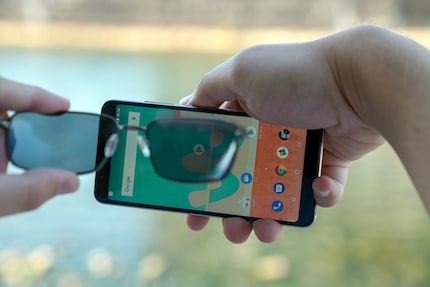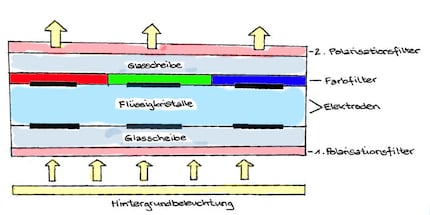
Bosch Professional Zubehör GBA ProCORE 8 Ah 18V+
18 V

A day by the river and I see black: why does the mobile phone screen stay dark when I look at it with polarised sunglasses? I want to find out.
It's a hot day. My girlfriend and I have found a cosy spot by the Limmat. I put on my new sunglasses - Oakley Titanium - and immediately want to take a few proof photos of this green oasis. Instagram, you understand.
"Läck, Bobby," I say.
"Nice, isn't it," says my girlfriend.
"I don't see anything," I reply.
I shuffle back into the shade, annoyed. There, I take off my glasses to get a clearer picture of the overall situation.
All of a sudden, everything is back.
Then the scales fall from my eyes: the polarisation filter on my sunglasses. It doesn't let through polarised light. I feel enlightened and start to explain the situation to my girlfriend.
The "trick" with the polarised glasses only works with smartphones, tablets, televisions or other monitors that are based on LCD technology. This is due to the way they work.
The two main features of LCD monitors are backlighting and liquid crystals. The crystals create the image and the light that makes them shine is provided by LEDs. They shine from behind onto two glass plates on which the polarisation filters, the electrodes and the colour filter are mounted. The centrepiece is located between the glass plates: the rod-shaped liquid crystals.
The two polarisation filters in the LCD panel ensure that the panel can alternate between light and dark - i.e. between white and black. This means that your LCD TV can display not only the glistening desert of the Wasteland from "Mad Max: Fury Road", but also the romantic night scene from "La La Land".
In simple terms, LED light consists of waves that oscillate vertically and horizontally. Think of these waves like guitar strings that start to vibrate when you pluck them. The first polarisation foil now absorbs the horizontally vibrating waves and lets the vertically vibrating waves through. This light is called "polarised light", or more precisely: vertically polarised light.
The polarised light then hits the liquid crystals. The crystals consist of rod-shaped molecules that are arranged like matches in a box. On the one hand, they behave like a liquid, but on the other hand they have an order similar to that of crystals - hence liquid crystals.
This is where the liquid crystals come into play.
The light waves coming out of the first filter have the same vertical arrangement of the matches. The alignment of the matches can be rotated using electrical voltage generated by the electrodes. What is even more practical is that the light waves rotate at the same time. By the time they hit the second, horizontally arranged polarisation filter, they have changed their orientation from vertical to horizontal and the light passes through.
So: If the image is to shine brightly, the electrodes change the orientation of the crystal molecules - and thus that of the light waves - from vertical to horizontal. This allows the light to pass through the second polarisation filter. If, on the other hand, the image is to remain dark, the electrodes do nothing and the horizontally aligned light waves do not pass through the second filter.
Of course, there is not just white and black. Depending on how bright the image is to be, the rod molecules of the liquid crystals - the matches - can also only be partially rotated. This allows differences in brightness and shades of grey to be created.
But why did my smartphone screen stay black when I looked at it with my polarised sunglasses?
From the above explanation, you can deduce that the light that reaches my sunglasses from my smartphone is already polarised. There is also a polarising film on the sunglasses lens that only allows certain light waves to pass through. Depending on how I look at my mobile - or in which orientation I hold it in front of me - the light waves are blocked and I only see a black screen.
This effect does not occur with screens based on OLED technology. OLEDs work without backlighting and therefore do not require polarisation filters, which only allow polarised light to pass through.
So, now I hope you've had the same epiphany as me.
Update, 16 August 2018, 17:00:
Another enlightenment: AMOLED screens don't need polarisation filters in theory, but in practice it's a different story. In fact, there are AMOLED mobiles that have such a filter installed. The reason for this is annoying reflections caused by light that penetrates the display from the outside and is reflected back by a low-lying, reflective film. The excess light then has a negative effect on the contrast range.
A single polarisation filter helps: The light coming from outside is polarised by the filter. The direction in which the light waves then oscillate is automatically reflected as soon as the film reflects the light. The reversely polarised light, which is now on its way back, can no longer pass through the polarisation filter.
Side effect: The light generated by the organic diodes is also polarised and you can no longer see anything with polarised sunglasses :).
Thanks to the users Spl4tt and Joshua4045 for the tip!
I write about technology as if it were cinema, and about films as if they were real life. Between bits and blockbusters, I’m after stories that move people, not just generate clicks. And yes – sometimes I listen to film scores louder than I probably should.
Practical solutions for everyday problems with technology, household hacks and much more.
Show all



The decisive factor is how the first and second polarisation filters are arranged in relation to each other. You can imagine the filters as a rod-shaped grid. It only lets through those light waves that have the same arrangement as the grating itself. The first and second filters are rotated by 90 degrees to each other. If the vertically polarised light were to hit the second, horizontally arranged polarisation filter unchanged, no light would get through and the image would simply remain black.





Bosch Professional Zubehör GBA ProCORE 8 Ah 18V+
18 V